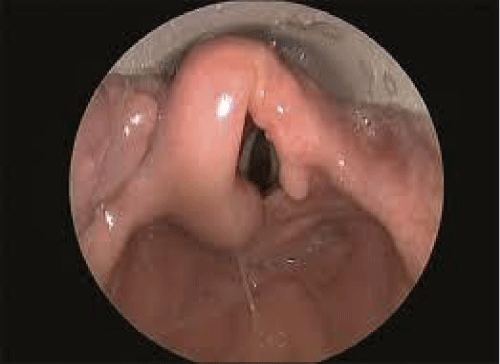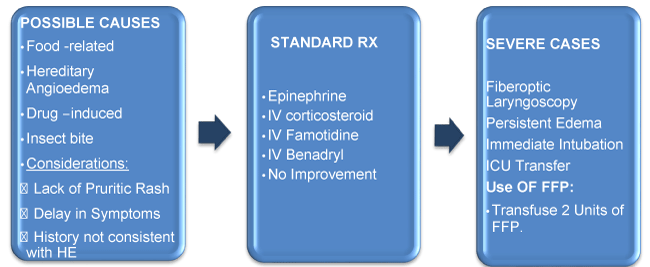Archive of Gerontology and Geriatrics Research
Angioedema, an uncommon side effect of Ace-Inhibitor use
Shaista U Ahmed1*, Ayobami Akenroye2 And Matthew McNabney1
2Department of Allergy and Clinical Immunology, Johns Hopkins School of Medicine, Baltimore, USA
Cite this as
Ahmed SU, Akenroye A, McNabney M (2018) Angioedema, an uncommon side effect of Ace-Inhibitor use. Peertechz J Gerontol Geriatr Res 3(1): 001-003. DOI: 10.17352/aggr.000006Angioedema is a rare but life-threatening side effect of angiotensin-converting enzyme inhibitor (ACEI). It can lead to airway compromise which can be fatal if not treated emergently. CASE: A 69-year-old woman presented to the ED with swollen lips, tongue and change of voice. Her home medications included aspirin, amlodipine, lisinopril and atorvastatin. She was treated with intravenous corticosteroids, diphenhydramine and famotidine. Fiberoptic laryngoscopy showed swollen base of the tongue and arytenoid process necessitating intubation for airway protection. Two units of fresh frozen plasma was given for persistent swelling. Her condition improved, she was extubated and discharged home on the third day. Possible causes of angioedema in her case were food- related, hereditary AE (HAE), and drug -induced. Aspirin and amlodipine related angioedema present early after initiation of these medications. In addition, these drugs typically lead to mast-cell mediated angioedema which is typically associated with a pruritic urticaria. By exclusion, this episode of angioedema was attributed to lisinopril. She was discharged home on aspirin and amlodipine and had no problems on follow up visit.
Angioedema associated with ACEI can occur years after initiation, is usually self- limited and rarely fatal. Prompt recognition and immediate treatment with standard therapy is usually sufficient. Laryngoscopy and early intubation when necessary are critical steps in y management of these patients. Fresh-frozen plasma has been used off -label use in refractory cases of angioedema and has shortened the time to resolution of angioedema complications.
Abbreviations
(ACEI) Angiotensin-Converting Enzyme Inhibitors; (AE) Angioedema; (FFP) Fresh Frozen Plasma; (HAE) Hereditary Engioedema.
Introduction
Angioedema (AE) is an uncommon but potentially life-threatening complication of the angiotensin converting enzyme inhibitors (ACEI) [1]. It is seen in 0.1-0.7 % of people taking this drug but since it is the highest prescribed anti-hypertensive agent, it accounts for one-third of prescription drug-related angioedema cases seen in the emergency room [2]. After the introduction of the first ACEI in 1980, ACEI quickly became the preferred drug for the treatment of HTN especially in patients with diabetes and heart failure [3]. Except for the common side effect of cough, it is well tolerated. ACEI angioedema is a class effect and is not dose dependent [4]. Lisinopril is by far the most commonly prescribed ACEI, and therefore the highest number of ACEI-AE are associated with the use of Lisinopril [5].
Not all of the ACEI- AE cases initially present to the ED; some of them are mild requiring no treatment and others are treated symptomatically by the physicians without much attention to the underlying cause of the AE. There is a growing concern that delay in diagnosis and continuation of the same ACEI or choosing another ACEI may result in life threatening attack of AE [6].
ACEI- AE is bradykinin- mediated, and therefore unlike mast cell- mediated AE is not typically associated with urticaria. It could affect the lips, tongue, upper airways and intestinal mucosa [7]. Although it is bradykinin-mediated, standard emergency treatment of this condition has still been mostly with antihistamine, steroids, and epinephrine. In a few instances, endotracheal intubation may be needed for airway protection. Without timely recognition and management some of these cases are fatal. To expedite resolution of airway edema, fresh frozen plasma has been successfully used. Fresh-frozen plasma contains Kininase II which acts to break down bradykinin into nonfunctional peptides, resulting in the rapid resolution of airway edema in ACEI-AE [8]. However, there is not sufficient data to support the use of other agents such as the kallikrein receptor antagonist (ecallantide) or the bradykinin receptor antagonist (icatibant) in ACE-AE [9-11].
We describe a case of angioedema caused by lisinopril after 8 years of using this drug, which failed to respond to traditional treatment, required endotracheal intubation and subsequently necessitated the use of fresh frozen plasma which led to successful resolution of the angioedema.
Case Presentation
A 69-year-old African-American woman presented to the ED with lip and tongue swelling. Her past medical history was notable for hypertension, hyperlipidemia, tobacco use, peripheral vascular disease, COPD and a cerebrovascular accident in 2009 with residual right-sided weakness. She had developed oral swelling and difficulty swallowing within a few hours of eating hotdogs for dinner. She reported no new food or medication use. There was no insect bite. She had no known allergies. A review of systems was unremarkable with no reported fever or rash. She had a similar episode of swelling 3 months back which responded to oral diphenhydramine. However, this episode did not respond to diphenhydramine. A few hours after dinner, she had developed difficulty breathing, drooling and weaker voice necessitating a visit to the emergency department (ED).
In the ED, her vital signs were normal, she was noted to have significant lip and tongue swelling but no urticarial rash, flushing, generalized pruritus, hypotension or wheezing. Her home medications included aspirin, lisinopril, atorvastatin and amlodipine. She had been on these medications since her stroke in 2009. She was treated with intravenous steroids, as well as H1 and H2 blockers. There was no improvement after 4 hours. Due to hoarsening of the voice, otolaryngology was consulted who then performed fiberoptic laryngoscopy which showed edema at the base of the tongue and on the arytenoid processes (Figure 1) with no vocal cords involvement. She was immediately intubated for airway protection.
Her blood work showed normal complete blood count and electrolytes, but elevated inflammatory markers - Erythrocyte sedimentation rate (ESR) was 45 and C-reactive protein (CRP) was 1.73, with normal complement levels. Her condition did not improve, which prompted consultation with the allergy specialist to rule out a hereditary angioedema or allergic conditions as underlying cause of symptoms. (Table1), Lisinopril was considered to be the culprit and since the standard treatment failed they recommend the use of fresh frozen plasma (FFP). Patient received 4 units of FFP, her symptoms resolved four hours after the transfusion. She was extubated the next day and was discharged home the day after the extubation on ASA, Amlodipine and tapering dose of oral prednisone. She was seen for follow up after a week in the clinic and at that time she was back to her baseline.
Discussion
Most cases of ACEI induced angioedema occur within hours to weeks after the initiation of the drug; however, with some cases the AE occurs after years of use [12]. In most instances it is self- limited [13], but occasionally it can result in fatal airway obstruction. Recurrent attacks of AE prior to diagnosis is not uncommon [14]. It is a class effect and using another ACEI agents is not recommended [15,16].
Although ACEI-AE commonly involves the mucous members of the mouth and upper airways, it can cause gut angioedema in which case it might be confused with hereditary AE (HAE), which more commonly has gut involvement [17]. Both ACEI-AE and HAE are bradykinin-mediated and thus, unlike mast-cell mediated angioedema, do not present with urticarial rash. In HAE, there is typically history of recurrent attacks [18]. The other important difference is the levels of C1 INH, C4 and C1q are normal in ACEI- AE. In the bradykinin- mediated angioedema pathway, blockade of the ACE enzyme by ACEI drugs leads to the accumulation of bradykinin, which is a potent vasodilator leading to the increased permeability of the vessels, and is thought to be the primary pathway leading to AE in these cases [19]. FFP has Kinninase II, an enzyme which is identical to ACE in the lung and helps in the breakdown of bradykinin and leads to rapid resolution of the edema [20].
Risk factors for the ACEI -AE includes: age greater than 65, African ancestry [21], female sex, history of smoking, concomitant use of immunosuppressive agents or having transplant status [22], history of seasonal allergies or previous angioedema [23]. It can be precipitated by trauma, instrumentation and use of anesthetic agents which sometimes lead to misdiagnosis of anesthetic agents induced AE [24].
Prompt recognition and early withdrawal of culprit ACEI is important. In individuals with severe airway edema, high-dose steroids and FFP, as in this case, can play a key role in resolution. In the most extreme of cases, close monitoring and early intubation could be necessary [25].
This off label use of FFP has been described for reversing the effects of ACEI-AE, especially in patients who have life threatening symptoms including dyspnea, dysphonia, odynophagia, stridor, drooling, or respiratory distress.
Conclusion
ACEI are highly effective agents used for a variety of health conditions, with increased use over the last few decades. This has led to a higher incidence of ACEI- AE. Delay in recognizing the culprit agent and prompt treatment could result in significant morbidity and mortality. Stopping the use of ACEI is critical in the prevention and management of angioedema. Fresh frozen plasma has shown promising results in selected cases of ACEI-AE and should be considered in patients with refractory symptoms.
VS thanks Founder President, Dr. Ashok K Chauhan at Amity University for providing a conducive environment and for being a constant source of inspiration.
- Sarkar P, Nicholson G, Hall G (2006) Brief review: Angiotensin converting enzyme inhibitors and angioedema: Anesthetic implications. Can J Anesth 53: 994-1003. Link: https://goo.gl/7y7NNK
- Banerji A, Clark S, Blanda M, LoVecchio F, Snyder B, et al. (2008) Multicenter study of patients with angiotensin-converting enzyme inhibitor-induced angioedema who present to the emergency department. Ann Allergy, Asthma Immunol 100: 327-332. Link: https://goo.gl/f3XCd7
- Smith RET, Ashiya M (2007) Antihypertensive therapies. Nat Rev Drug Discov 6: 597-598.
- Howes LG, Tran D (2002) Can angiotensin receptor antagonists be used safely in patients with previous ACE inhibitor-induced angioedema? Drug Saf 25: 73-76. Link: https://goo.gl/9wz4rj
- Sondhi D, Lippmann M, Murali G (2004) Airway Compromise Due to Angiotensin-Converting Enzyme Inhibitor-Induced Angioedema: Clinical Experience at a Large Community Teaching Hospital. Chest 126: 400-404. Link: https://goo.gl/o4FDKq
- American Academy of Family Physicians. A (1970) American Family Physician. Vol 66. American Academy of Family Physicians. Link: https://goo.gl/a64Y6r
- Kostis WJ, Shetty M, Singh Chowdhury Y, Kostis JB (2018) ACE Inhibitor-Induced Angioedema: a Review. Link: https://goo.gl/n94dAo
- Stewart M, McGlone R (2012) Fresh frozen plasma in the treatment of ACE inhibitor-induced angioedema. BMJ Case Rep. Link: https://goo.gl/uZKd1k
- Rasmussen E, Mey K, Bygum A (2014) Angiotensin-converting Enzyme Inhibitor-induced Angioedema – A Dangerous New Epidemic. Acta Derm Venereol 94: 260-264. Link: https://goo.gl/TGTwV5
- Lewis CL, Moore, Golin CG, Griffith, Tytell-Brenner (2008) Resident physicians’ life expectancy estimates and colon cancer screening recommendations in elderly patients 28: 254-261. Link: https://goo.gl/pUVxkg
- Kanani A, Schellenberg R, Warrington R (2011) Urticaria and angioedema. Allergy, Asthma Clin Immunol 7: S9.
- Tharayil AM, Chanda AH, Shiekh HA, Elkhatib MS, Nayeemuddin M, et al. (2014) Life threatening angioedema in a patient on ACE inhibitor (ACEI) confined to the upper airway. Qatar Med J 2014: 92-97. Link: https://goo.gl/511nJk
- Morimoto T, Gandhi TK, Fiskio JM (2004) An evaluation of risk factors for adverse drug events associated with angiotensin-converting enzyme inhibitors. J Eval Clin Pract 10: 499-509. Link: https://goo.gl/QqVQ9Z
- Gibbs CR, Lip GY, Beevers DG (1999) Angioedema due to ACE inhibitors: increased risk in patients of African origin. Br J Clin Pharmacol 48: 861-865. Link: https://goo.gl/2UEi7f
- Cicardi M, Zingale LC, Bergamaschini L, Agostoni A (2004) Angioedema Associated With Angiotensin-Converting Enzyme Inhibitor Use. Arch Intern Med 164: 910. Link: https://goo.gl/NS7rE1
- Kaplan AP, Greaves MW (2005) Angioedema. J Am Acad Dermatol 53: 373-388.
- Nzeako UC, Longhurst HJ (2012) Many faces of angioedema. Eur J Gastroenterol Hepatol 24: 1. Link: https://goo.gl/TQzW3G
- Moellman JJ, Bernstein JA, Lindsell C (2014) A consensus parameter for the evaluation and management of angioedema in the emergency department. Acad Emerg Med 21: 469-484. Link: https://goo.gl/hKrV4V
- Craig TJ, Bernstein JA, Farkas H, Bouillet L, Boccon-Gibod I (2014) Diagnosis and treatment of bradykinin-mediated angioedema: outcomes from an angioedema expert consensus meeting. Int Arch Allergy Immunol 165: 119-127. Link: https://goo.gl/XxRgyB
- Culley CM, Dibridge JN, Wilson GL (2016) Off-label use of agents for management of serious or life-threatening angiotensin converting enzyme inhibitor–induced angioedema. Ann Pharmacother. Link: https://goo.gl/XSYLbz
- Loftus PA, Tan M, Patel G (2014) Risk factors associated with severe and recurrent angioedema: An epidemic linked to ACE-inhibitors. Laryngoscope 124: 2502-2507. Link: https://goo.gl/SkUzya
- Vasekar M, Craig TJ (2012) ACE Inhibitor–Induced Angioedema. Curr Allergy Asthma Rep 12: 72-78. Link: https://goo.gl/u4Ap3t
- Hoover T, Lippmann M, Grouzmann E, Marceau F, Herscu P (2010) Angiotensin converting enzyme inhibitor induced angio-oedema: A review of the pathophysiology and risk factors. Clin Exp Allergy 40: 50-61. Link: https://goo.gl/C5NKFB
- Bezalel S, Mahlab-Guri K, Asher I, Werner B, Sthoeger ZM (2015) Angiotensin-converting enzyme inhibitor-induced angioedema. Am J Med 128: 120-125.
- Winters ME, Rosenbaum S, Vilke GM, Almazroua FY (2013) AAEM Clinical Practice EMERGENCY DEPARTMENT MANAGEMENT OF PATIENTS WITH ACE-INHIBITOR ANGIOEDEMA. Link: https://goo.gl/xUhd4g
Article Alerts
Subscribe to our articles alerts and stay tuned.
 This work is licensed under a Creative Commons Attribution 4.0 International License.
This work is licensed under a Creative Commons Attribution 4.0 International License.



 Save to Mendeley
Save to Mendeley
